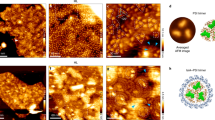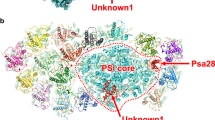Abstract
By means of circular dichroism (CD) spectroscopy, we have characterized the organization of the photosynthetic complexes of the diatom Phaeodactylum tricornutum at different levels of structural complexity: in intact cells, isolated thylakoid membranes and purified fucoxanthin chlorophyll protein (FCP) complexes. We found that the CD spectrum of whole cells was dominated by a large band at (+)698 nm, accompanied by a long tail from differential scattering, features typical for psi-type (polymerization or salt-induced) CD. The CD spectrum additionally contained intense (−)679 nm, (+)445 nm and (−)470 nm bands, which were also present in isolated thylakoid membranes and FCPs. While the latter two bands were evidently produced by excitonic interactions, the nature of the (−)679 nm band remained unclear. Electrochromic absorbance changes also revealed the existence of a CD-silent long-wavelength (∼545 nm) absorbing fucoxanthin molecule with very high sensitivity to the transmembrane electrical field. In intact cells the main CD band at (+)698 nm appeared to be associated with the multilamellar organization of the thylakoid membranes. It was sensitive to the osmotic pressure and was selectively diminished at elevated temperatures and was capable of undergoing light-induced reversible changes. In isolated thylakoid membranes, the psi-type CD band, which was lost during the isolation procedure, could be partially restored by addition of Mg-ions, along with the maximum quantum yield and the non-photochemical quenching of singlet excited chlorophyll a, measured by fluorescence transients.







Similar content being viewed by others
Abbreviations
- CD:
-
Circular dichroism
- Chl a :
-
Chlorophyll a
- Chl c :
-
Chlorophyll c
- DDE:
-
Diadinoxanthin-deepoxidase
- Ddx:
-
Diadinoxanthin
- DM:
-
n-Dodecyl-β-d-maltoside
- Dtx:
-
Diatoxanthin
- FCP:
-
Fucoxanthin-chlorophyll a/c binding protein
- Fx:
-
Fucoxanthin
- LD:
-
Linear dichroism
- LHC:
-
Light-harvesting complex
- NPQ:
-
Non-photochemical chlorophyll fluorescence quenching
- PAM:
-
Pulse amplitude modulated chlorophyll fluorometer
- PAR:
-
Photosynthetically active radiation
- PSI:
-
Photosystem I
- PSII:
-
Photosystem II
- psi-type:
-
Polymerization or salt-induced
References
Akimoto S, Yamazaki I, Murakami A, Takaichi S, Mimuro M (2004) Ultrafast excitation relaxation dynamics and energy transfer in the siphonaxanthin-containing green alga Codium fragile. Chem Phys Lett 390:45–49
Akimoto S, Tomo T, Naitoh Y, Otomo A, Murakami A, Mimuro M (2007) Identification of a new excited state responsible for the in vivo unique absorbtion band of siphonaxanthin in the green alga Codium fragile. J Phys Chem B 111:9179–9181
Barzda V, Mustárdy L, Garab G (1994) Size dependency of circular-dichroism in macroaggregates of photosynthetic pigment–protein complexes. Biochemistry 33:10837–10841
Barzda V, Istokovics A, Simidjiev I, Garab G (1996) Structural flexibility of chiral macroaggregates of light-harvesting chlorophyll a/b pigment–protein complexes. Light-induced reversible structural changes associated with energy dissipation. Biochemistry 35:8981–8985
Berkaloff C, Caron L, Rousseau B (1990) Subunit organization of PS I particles from brown algae and diatoms: polypeptide and pigment analysis. Photosynth Res 23:181–193
Bilger W, Björkmann O (1990) Role of the xanthophyll cycle in photoprotection elucidated by measurements of light-induced absorbance changes, fluorescence and photosynthesis in leaves of Hedera canariensis. Photosynth Res 25:173–185
Büchel C (2003) Fucoxanthin-chlorophyll proteins in diatoms: 18 and 19 kDa subunits assemble into different oligomeric states. Biochemistry 42:13027–13034
Büchel C, Garab G (1995) Electrochromic absorbance changes in the chlorophyll-c-containing alga Pleurochloris meiringensis (Xanthophyceae). Photosynt Res 43:49–56
Büchel C, Garab G (1997) Organization of the pigment molecules in the chlorophyll a/c light-harvesting complex of Pleurochloris meiringensis (Xanthophyceae). Characterization with circular dichroism and absorbance spectroscopy. J Photochem Photobiol B 37:118–124
Büchel C, Wilhelm C, Hauswirth N, Wild A (1992) Evidence for a lateral heterogeneity by patch-work like areas enrichted with photosystem I complexes in three thylakoid lamellae of Pleurochloris meiringensis (Xanthophyceae). Crypt Bot 2:375–386
Chow WS, Kim EH, Horton P, Anderson JM (2005) Granal stacking of thylakoid membranes in higher plant chloroplasts: the physicochemical forces at work and the functional consequences that ensue. Photochem Photobiol Sci 4:1081–1090
Cseh Z, Rajagopal S, Tsonev T, Busheva M, Papp E, Garab G (2000) Thermooptic effect in chloroplast thylakoid membranes. Thermal and light stability of pigment arrays with different levels of structural complexity. Biochemistry 39:15250–15257
Cseh Z, Vianelli A, Rajagopal S, Krumova S, Kovács L, Papp E, Barzda V, Jennings R, Garab G (2005) Thermo-optically induced reorganizations in the main light harvesting antenna of plants. I. Non-arrhenius type of temperature dependence and linear light-intensity dependencies. Photosynth Res 86:263–273
de Grooth BG, van Gorkom HJ, Meiburg RF (1980) Electrochromic absorbance changes in spinach chloroplasts induced by an external electrical field. Biochim Biophys Acta 589:299–314
Durnford DG, Aebersold R, Green BR (1996) The fucoxanthin-chlorophyll proteins from a chromophyte alga are part of a large multigene family: structural and evolutionary relationships to other light harvesting antennae. Mol Gen Genet 253:377–386
Eppard M, Rhiel E (1998) The genes encoding light-harvesting subunits of Cyclotella cryptica (Bacillariophyceae) constitute a complex and heterogeneous family. Mol Gen Genet 260:335–345
Faludi-Dániel A, Demeter S, Garay AS (1973) Circular dichroism spectra of granal and agranal chloroplasts of maize. Plant Physiol 52:54–56
Garab G (1996) Linear and circular dichroism. In: Amesz J, Hoff AJ (eds) Biophysical techniques in photosynthesis, advances in photosynthesis, vol 3. Kluwer Academic Publishers, Dordrecht, pp 11–40
Garab G, Kieleczawa J, Sutherland JC, Bustamante C, Hind G (1991) Organization of pigment protein complexes into macrodomains in the thylakoid membranes of wild-type and chlorophyll-b-less mutant of barley as revealed by circular-dichroism. Photochem Photobiol 54:273–281
Gibbs S (1962) The ultrastructure of the chloroplasts of algae. J Ultrastruct Res 7:418–435
Gillbro T, Andersson PO, Liu RSH, Asato AE, Takaishi S, Cogdell RJ (1993) Location of the carotenoid 2A(G)-state and its role in photosynthesis. Photochem Photobiol 57:44–48
Goss R, Wilhelm C, Garab G (2000) Organization of the pigment molecules in the chlorophyll a/b/c-containing alga Mantoniella squamata (Prasinophyceae) studied by means of absorption, circular and linear dichroism spectroscopy. Biochem Biophys Acta 1457:190–199
Grossman A (1990) Light-harvesting proteins of diatoms: their relationship to the chlorophyll a/b binding proteins of higher plants and their mode of transport into plastids. Mol Gen Genet 224:91–100
Hiller RG, Breton J (1992) A linear dichroism study of photosynthetic pigment organization in two fucoxanthin-containing algae. Biochim Biophys Acta 1102:365–370
Istokovics A, Simidjiev I, Lajkó F, Garab G (1997) Characterization of the light induced reversible changes in the chiral macroorganization of the chromophores in chloroplast thylakoid membranes. Temperature dependence and effect of inhibitors. Photosynth Res 54:45–53
Jeffrey SW, Humphrey GF (1975) New spectrophotometric equations for determining chlorophylls a, b, c1, c2 in higher plants, algae and natural phytoplankton. Biochem Physiol Pflanz 167:191–194
Joliot P, Joliot A (1989) Characterization of linear and quadratic electrochromic probes in Chlorella sorokiniana and Chlamydomonas reinhardtii. Biochim Biophys Acta 975:355–360
Kakitani T, Honig B, Crofts AR (1982) Theoretical studies of the electrochromic response of carotenoids in photosynthetic membranes. Biophys J 39:57–63
Katoh T (1992) S1 state of fucoxanthin involved in energy transfer to chlorophyll a in the light-harvesting proteins of brown algae. In: Murata N (ed) Research in photosynthesis. Proceedings of the IXth international congress on photosynthesis, Nagoya, Japan, September 1992, vol 1. Kluwer Academic Publishers, Dordrecht, p 227
Keller D, Bustamante C (1986) Theory of the interaction of light with large inhomogeneous molecular aggregates. 2. Psi-type circular-dichroism. J Chem Phys 84:2972–2980
Lepetit B, Volke D, Szabó M, Hoffmann R, Garab G, Wilhelm C, Goss R (2007) Spectroscopic and molecular characterization of the oligomeric antenna of the diatom Phaeodactylum tricornutum. Biochemistry 46:9813–9822
Lohr M, Wilhelm C (2001) Xanthophyll synthesis in diatoms: quantification of putative intermediates and comparison of pigment conversion kinetics with rate constants derived from a model. Planta 212:382–391
Martinson TA, Ikeuchi M, Plumey FG (1998) Oxygen evolving diatom thylakoid membranes. Biochim Biophys Acta 1409:72–83
Mimuro M, Katoh T, Kawai H (1990) Spatial arrangement of pigments and their interaction in the fucoxanthin-chlorophyll a/c protein assembly (FCPA) isolated from the brown alga Dictyota dichotoma—analysis by means of polarized spectroscopy. Biochem Biophys Acta 1015:450–456
Noctor G, Ruban AV, Horton P (1993) Modulation of ΔpH dependent non-photochemical quenching of chlorophyll fluorescence in spinach chloroplasts. Biochim Biophys Acta 1183:339–344
Owens TG (1986a) Light-harvesting function in the diatom Phaeodactylum tricornutum, I: isolation and characterization of pigment–protein complexes. Plant Physiol 80:732–738
Owens TG (1986b) Light-harvesting function in the diatom Phaeodactylum tricornutum, II: distribution of excitation energy between the photosystems. Plant Physiol 80:739–746
Palacios MA, Caffarri S, Bassi R, van Grondelle R, van Amerongen H (2004) Stark effect measurements on monomers and trimers of reconstituted light-harvesting complex II of plants. Biochim Biophys Acta 1656:177–188
Papagiannakis E, van Stokkum I, Fey H, Büchel C, van Grondelle R (2005) Spectroscopic characterisation of the excitation energy transfer in the fucoxanthin-chlorophyll proteins of diatoms. Photosynth Res 86:241–250
Provasoli L, McLaughin JJA, Droop MR (1957) The development of artificial media for marine algae. Arch Microbiol 25:392–428
Pyszniak AM, Gibbs SP (1992) Immunochemical localization of photosystem-I and the fucoxanthin-chlorophyll-a/c light-harvesting complex in the diatom Phaeodactylum tricornutum. Protoplasma 166:208–217
Rees D, Horton P (1990) The mechanism of changes in photosystem II efficiency in spinach thylakoids. Biochim Biophys Acta 1016:219–227
Sewe KV, Reich R (1977) Effect of molecular polarization on electrochromism of carotenoids. 2. Lutein–chlorophyll complexes—origin of field-indicating absorption change at 520 nm in membranes of photosynthesis. Z Naturforsch C 32:161–171
Telfer A, Nicolson J, Barber J (1976) Cation control of chloroplast structure and chlorophyll a fluorescence yield and its relevance to the intact chloroplast. FEBS Lett 65:77–83
Wilhelm C, Büchel C, Fisahn J, Goss R, Jakob T, Kroth P, LaRoche J, Lavaud J, Lohr M, Riebesell U, Stehfest K, Valentin K (2006) The regulation of carbon and nutrient assimilation in diatoms is significantly different from green algae. Protist 157:91–124
Acknowledgments
We are grateful to Prof. Mamoru Mimuro for critical reading of the manuscript, to Prof. Kornél Kovács (Biotechnology Department, University of Szeged, Hungary) for the use of their French pressure cell system and to Balázs Bálint for technical help. This work was supported by grants MC-RTN-CT 2003-505069 (INTRO2), OTKA K63252 and T42696 and by DAAD-MÖB project (9/2006-7).
Author information
Authors and Affiliations
Corresponding author
Rights and permissions
About this article
Cite this article
Szabó, M., Lepetit, B., Goss, R. et al. Structurally flexible macro-organization of the pigment–protein complexes of the diatom Phaeodactylum tricornutum . Photosynth Res 95, 237–245 (2008). https://doi.org/10.1007/s11120-007-9252-3
Received:
Accepted:
Published:
Issue Date:
DOI: https://doi.org/10.1007/s11120-007-9252-3




